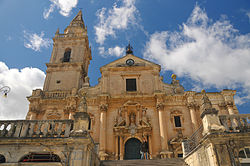This article relies largely or entirely on a single source .(February 2024) |
Province of Ragusa | |
|---|---|
| Free Municipal Consortium of Ragusa Libero consorzio comunale di Ragusa (Italian) Lìbbiru cunsòrziu cumunali di Raùsa (Sicilian) | |
 Palazzo della Provincia, the provincial seat, 2025 | |
 Map highlighting the location of the province of Ragusa in Italy | |
| Coordinates: 36°55′30″N14°43′50″E / 36.92500°N 14.73056°E | |
| Country | |
| Region | Sicily |
| Capital(s) | Ragusa |
| Comuni | 12 |
| Government | |
| • President | Maria Rita Annunziata Schembari (FdI) |
| Area | |
• Total | 1,623.89 km2 (626.99 sq mi) |
| Population (2025) [1] | |
• Total | 320,976 |
| • Density | 200/km2 (510/sq mi) |
| GDP | |
| • Total | €5.570 billion (2015) |
| • Per capita | €17,428 (2015) |
| Time zone | UTC+1 (CET) |
| • Summer (DST) | UTC+2 (CEST) |
| Postal code | 97100, 97010-97015, 97017-97019 |
| Telephone prefix | 0932 |
| Vehicle registration | RG |
| ISTAT | 088 |

The province of Ragusa (Italian : provincia di Ragusa; Sicilian : pruvincia di Rausa) was a province in the autonomous region of Sicily, Italy, located in the southeast of the island. Following the abolition of the Sicilian provinces, it was replaced in 2015 by the Free municipal consortium of Ragusa (Italian: Libero consorzio comunale di Ragusa; Sicilian: Lìbbiru cunsòrziu cumunali di Rausa). Its capital is the city of Ragusa, which is the most southern provincial capital in Italy. It has 320,976 inhabitants as of 2025. [1]





